Guide To Almost Eradicated And Entirely Eradicated Infectious Diseases
The eradication of infectious diseases is a goal for many medical researchers. To determine whether a particular disease could potentially be eradicated, scientists note the disease must meet certain criteria. First, the disease needs to be easy to diagnose, and it must not have an animal host since these hosts would need to become extinct for the disease to be successfully eradicated. In addition, the disease cannot lie dormant within a patient for many years, and it needs to follow a cyclic pattern of rise and decline that creates natural immunity in individuals who have survived the disease. Any vaccines or treatments must be cost-effective and easily administered, and the disease must attract the attention of both public health and government officials.
The diseases described below include those that have been eradicated and those scientists believe could likely be eradicated in the future.
Smallpox

With the last confirmed case of smallpox occurring in 1977, the disease was officially certified as eradicated in 1980. The successful worldwide eradication of smallpox was attributed to an effective global vaccination campaign. The smallpox vaccine, the world's first inoculation, was created by Edward Jenner in 1796. While military members are still routinely vaccinated for this disease, vaccination for other individuals ceased after smallpox was eradicated. Samples of the virus are stored for research purposes. Patients infected with smallpox usually survived, but they were often left with deep scarring that could be disfiguring. After an incubation period of up to seventeen days, patients with smallpox would first experience fever, severe back pain, headaches, and extreme fatigue. As the virus progressed, a rash would appear on the patient's face and arms before spreading to their torso. The spots frequently turned into pus-filled blisters that scabbed over and left pitted scars. In addition to these severe scars, blindness was a possible complication of smallpox.
Continue for more details on eradicated and almost eradicated infectious diseases now.
Guinea Worm Disease

Also known as dracunculiasis, Guinea worm disease is a parasitic infection caused by Dracunculus medinensis. Infection occurs when an individual ingests water containing Guinea worm larvae. Patients typically show no symptoms for up to a year after infection. During this time, the worm larvae mature inside the patient's body. Eventually, a painful blister forms, typically on the foot or leg. This blister bursts a few days or weeks later, and the mature female worm emerges from the skin. To relieve the pain of the blister, patients often try to immerse the leg or foot in water. This releases worms into the water supply, and they can then infect others. Individuals with Guinea worm disease may have a fever, vomiting, nausea, and diarrhea. There are no medications or vaccines that can treat or prevent Guinea worm disease, and patients may be able to have the worms surgically removed before a blister develops. Efforts to eradicate this disease are ongoing, and there were only twenty-eight cases of the illness in 2018.
Learn about where polio ranks on this list next.
